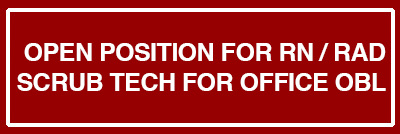Follow Us x
Venous Ablations
What is it?
Radio Frequency Venous Ablation
This minimally invasive procedure uses radiofrequency to provide consistent and uniform heat to contract the collagen in the vein wall, thus causing them to shrink and seal closed.
This minimally invasive procedure uses radiofrequency to provide consistent and uniform heat to contract the collagen in the vein wall, thus causing them to shrink and seal closed.
Why you are having this procedure (symptoms/indications):
Your doctor may have ordered this procedure if you have varicose veins, leg or ankle swelling, leg heaviness and fatigue, leg pain, aching or cramping in the legs, burning or itching of the skin, restless legs, skin changes or rashes, ulcers or open wounds or sores.
Prep for the procedure:
If you have been using the compression hose, you should stop wearing them 3 days prior to the procedure. You will be given a prescription for Valium which you should take 1 tablet 30 minutes prior to arriving for the procedure and bring the remaining tablets for later. You will need to be well hydrated for the procedure so drink lots of liquids. Take all of your medications as prescribed. Following the procedure, a compression bandage will be applied and should stay in place for 24 hours. After the dressing is removed you will wear the compression hose for another 10 days. Please have someone drive you to the office and drive you home. 48-72 hours after the procedure, we will evaluate your results using ultrasound.
What to expect:
Your leg will be anesthetized with a local anesthetic agent. The first stage of the procedure will involve inserting a small catheter at the level of the knee and feeding it up the saphenous vein (the root of your problem) under ultrasound guidance. Then the catheter is slowly removed as it is firing; as it is removed it closes off the saphenous vein. This will relieve the backflow pressure, which is causing your symptoms. Varicose veins and spider veins are chronic and recurrent conditions. The variety of treatments available will not offer a cure, but rather a control of the condition. Your tendency towards developing new veins will not be relieved by this or any other form of treatment. It is important to have yearly ultrasound exams to follow your progress.
Risks:
All surgical interventions carry an inherent risk of infection, allergic reaction, bleeding, and anesthetic complications including cardiopulmonary complications. Allergic Reaction – very rarely, a patient may have an allergic reaction to the anesthetic agent. The risk is greater for those that have a history of allergies. Pain – Patients may experience moderate to severe pain following the procedure. The leg may be tender and an uncomfortable sensation may run along the vein route. This is usually temporary. Swelling – this may occur after treatment. It will usually resolve in a few days but may last for a few weeks, especially after treatment of large varicose veins. Wearing the prescribed compression hose will lessen the ankle swelling. Skin burns – this procedure carries a very small risk of skin burns which may require additional treatment. Deep Vein Thrombosis - this is a very rare complication. The dangers include the possibility of pulmonary embolus (a blood clot carried to the lungs) and post phlebitic syndrome, resulting in a permanent swelling of the leg. Transient Hyperpigmentation - patients who have had this procedure may notice some discoloration after the treatment. This discoloration is almost always transient and will resolve in about three months. In rare cases, this darkening of the skin may persist up to a year. Nodularity – Nodularity of the treated vein may persist for up to a year. This occurs when the vein has scarred down and becomes hard. With time, the body will absorb and soften these areas but some may persist – A skin ulcer may develop at the site of the injection. This is a rare complication. In the event of a skin ulcer, it may take months for the area to heal. Nerve trauma - Occasionally there can be trauma to the surrounding nerves which can result in transient numbness that will resolve on its own with time. In rare instances the localized numbness may be permanent. Reoccurrence of New Veins – When a patient has varicose veins it is usually an ongoing problem. Several years after the vein has been treated, the body will attempt to repair itself by taking veins that were insignificant and make them significant. We recommend a yearly follow-up with ultrasound so that we can detect any new problems and treat them accordingly as they arise.
Please be aware that in addition to the risks listed, there are other risks that may accompany any surgical procedures, such as loss of blood, infection, and inflammation in the venous system with the formation of a thrombus (clot), postoperative bleeding, and nerve trauma that may lead to temporary or permanent numbness.
Please be aware that in addition to the risks listed, there are other risks that may accompany any surgical procedures, such as loss of blood, infection, and inflammation in the venous system with the formation of a thrombus (clot), postoperative bleeding, and nerve trauma that may lead to temporary or permanent numbness.
Post procedure instructions/limitations:
Immediately after the procedure you must walk for 20 minutes. Regular 20-30 minute walks should be done every 2-3 hours during the day to prevent a clot and to minimize tenderness. This needs to be done for at least the first 5 days. Staying active will help the leg from becoming tight.
You should expect some bruising, soreness, a tight feeling and a “pulling sensation” in the treated limb, which is all to be expected for 2-3 weeks. You may also feel a knot or rope in the inner thigh to below the knee. It is the closed vein and will go away over time. It can take up to 6 months, even a year for it to disappear completely.
There will be liquid that will seep out of the compression wrap/bandage in the areas that were treated (thigh). It should be clear to pinkish in color. If there is any significant bleeding, please call our office.
Showering is not permitted during the first 24 hours after the procedure. Following the first 24 hours you may shower in cooler than normal water without your stockings. After a shower, pat your skin dry and put on compression stockings. Please avoid hot baths, hot tubs, swimming pools, saunas and sunlight (including tanning beds) for 2 weeks.
Normal activities may be resumed the day after the procedure. Please avoid strenuous activity for at least 7 days following the procedure to prevent the vein from re-opening.Please do not apply hot packs or heating pads.
We recommend a follow-up ultrasound in 48-72 hours and also a 6 month and yearly ultrasound are recommended.
You should expect some bruising, soreness, a tight feeling and a “pulling sensation” in the treated limb, which is all to be expected for 2-3 weeks. You may also feel a knot or rope in the inner thigh to below the knee. It is the closed vein and will go away over time. It can take up to 6 months, even a year for it to disappear completely.
There will be liquid that will seep out of the compression wrap/bandage in the areas that were treated (thigh). It should be clear to pinkish in color. If there is any significant bleeding, please call our office.
Showering is not permitted during the first 24 hours after the procedure. Following the first 24 hours you may shower in cooler than normal water without your stockings. After a shower, pat your skin dry and put on compression stockings. Please avoid hot baths, hot tubs, swimming pools, saunas and sunlight (including tanning beds) for 2 weeks.
Normal activities may be resumed the day after the procedure. Please avoid strenuous activity for at least 7 days following the procedure to prevent the vein from re-opening.Please do not apply hot packs or heating pads.
We recommend a follow-up ultrasound in 48-72 hours and also a 6 month and yearly ultrasound are recommended.
When to contact your doctor:
Contact your physician if you experience the following:
- Treated areas that become increasingly sore, tender, red or warm
- Discomfort not relieved by pain medication
- Fever higher than 100.4 degrees
- Significant swelling or pain in your leg
- Darkening or ulceration (sores) on areas of the skin






